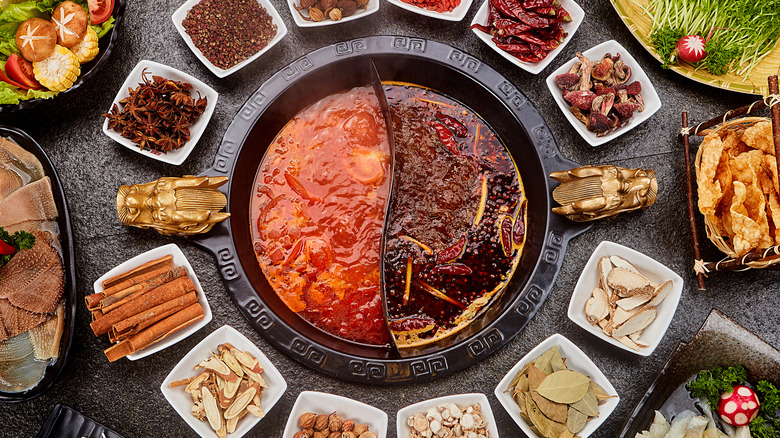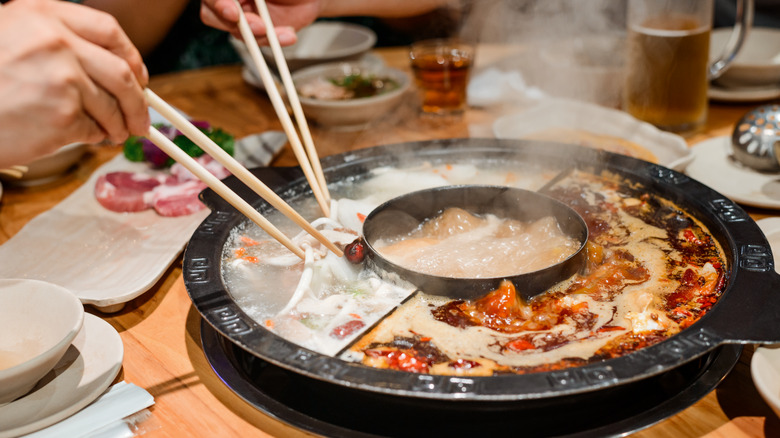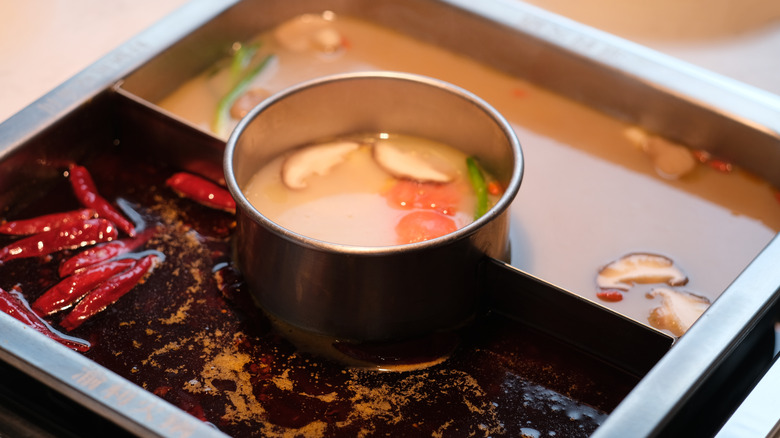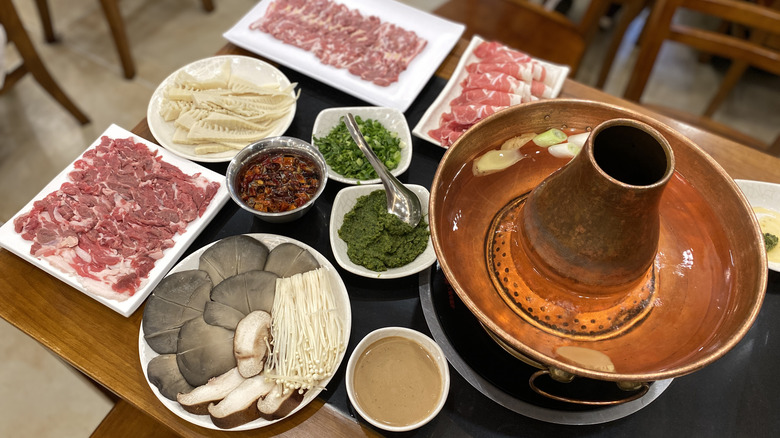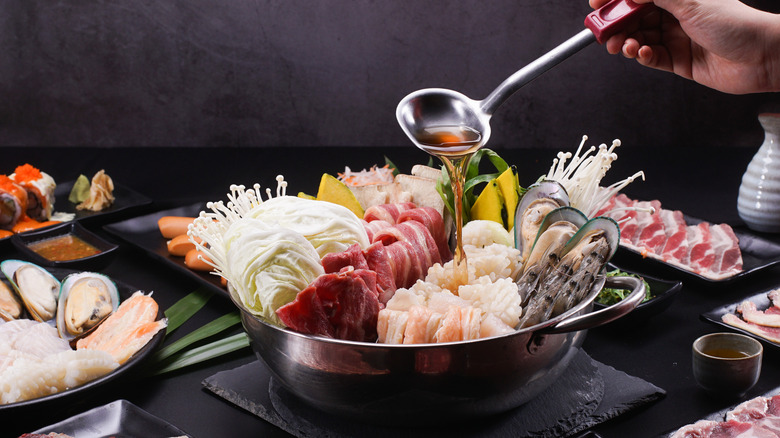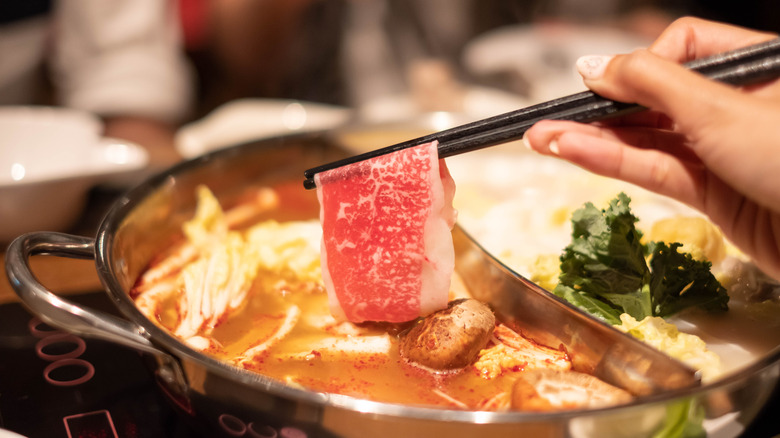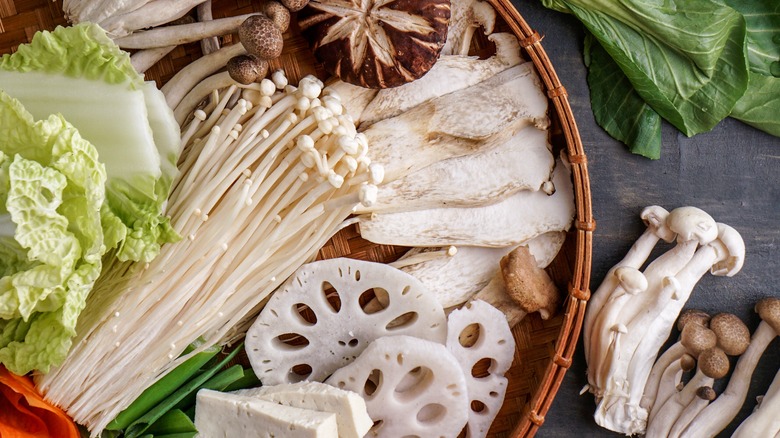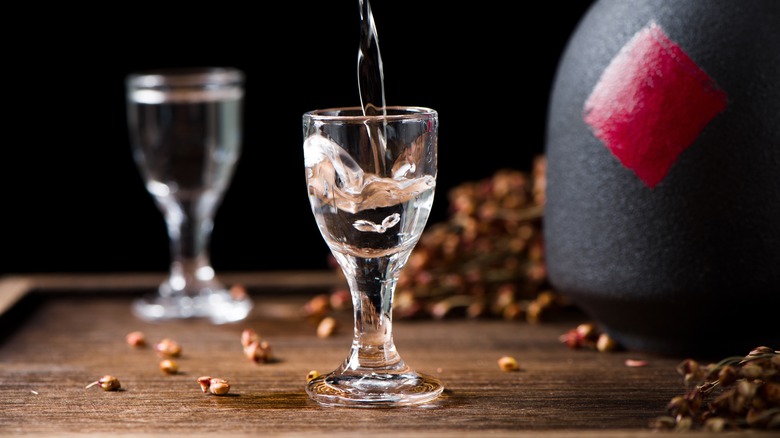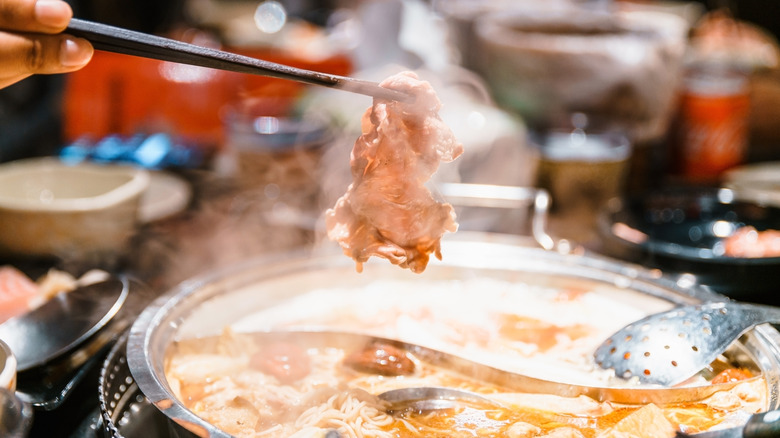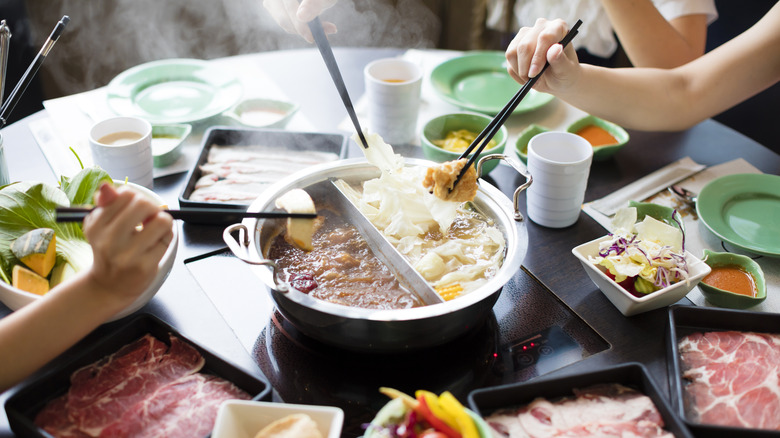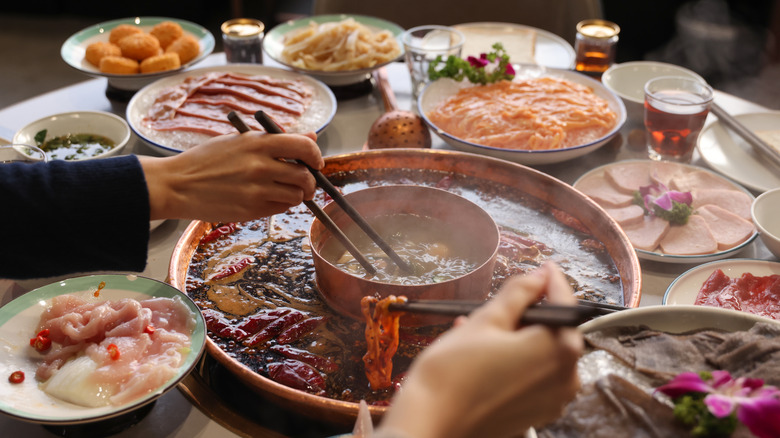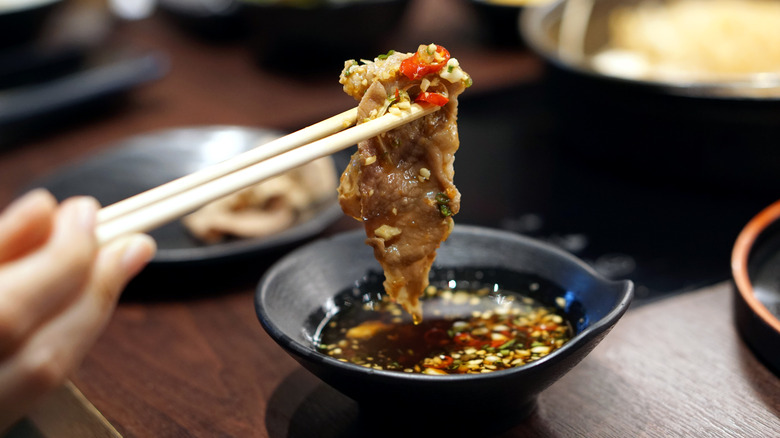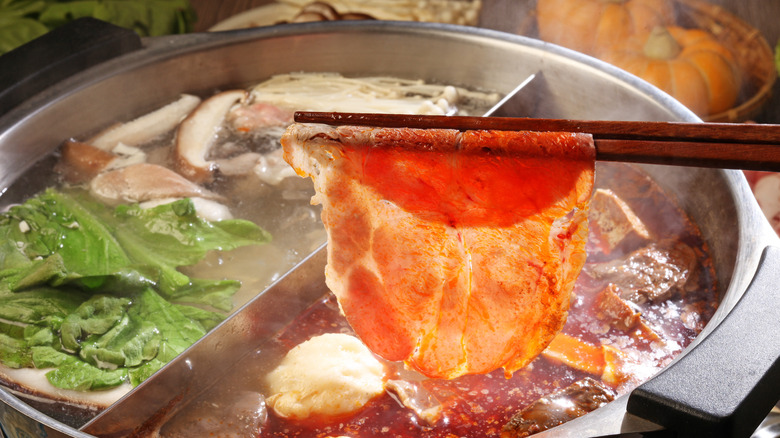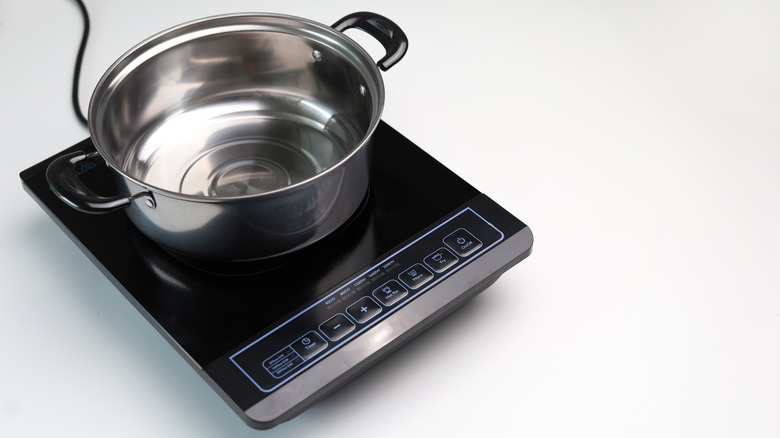14 Facts You Need To Know About Hot Pot
You're probably no stranger to the age-old line, "What's for dinner?" Takeout pizza seems like it's becoming all too common in your household routine, and the formidable dishes in your sink may make you a little resistant to cooking another meal for yourself. On your Yelping for local restaurants, you may stumble upon a type of restaurant you've never heard of: hot pot.
Hot pot is the meal option that is more than just eating what is ordered and placed in front of you. Instead, hot pot is an experience that allows you to create your own texture and flavor combinations — plus, it leaves you filling full and satisfied. But what exactly is hot pot, and how do you make the most out of your hot pot experience? Here is everything you need to know about hot pot in order to enjoy your meal and not go into it with any lingering questions.
Hot pot is kind of like fondue, but for soup
Hot pot is a relatively simple culinary experience to describe. Hot pot restaurants are designed to serve hot pot fare — although you may find a few additional items on the menu that you don't have to cook yourself. Diners order a soup base for their table and different add-ins to cook in their soup. These items, which include meat, seafood, mushrooms, vegetables, and tofu, are brought to the table raw.
Once everything has arrived, diners turn the central heating plate in the middle of the table on and heat the broth until it simmers before plunging in their raw accompaniments and retrieving them within a matter of minutes. Many hot pot restaurants also offer dipping sauces for customers, either pre-made or buffet-style. Hot pot is essentially as much of a cooking experience as a social one. It is meant to be enjoyed leisurely with friends and family, so it's typical for the entire dining experience to take several hours.
Hot pot is rooted in Chinese tradition
Hot pot in Chinese is huǒguō — which translates to "fire pot." The tradition of cooking this soup likely originated in China over 1,000 years ago. One of the original origin stories for this culinary tradition was Mongol soldiers would camp out and eat meals circled around a fire. It is also suggested that the soldiers used their helmets to cook the water in since they likely had very few cooking utensils at their disposal. Another origin story claims that Chongqing boatmen invented hotpot as an inexpensive and easy way to prepare meals.
Ownership of hot pot has not come without controversy, and there are conflicting theories behind hot pot's origins. In 2018, Anhui Province, located in southeastern China, claimed ownership over the culinary tradition. But the members of China's Sichuan Province, located in southwest China, retorted that hot pot would be nothing without its spices and contributions to the fame and reverence of the dish in China. So, we'll settle on a joint effort.
There are regional variations on hot pot within China
If you have the opportunity to sample the diverse range of hot pots in China, you surely won't be disappointed. Each variation in style has different hot pot ingredients and flavors, making the style different from other regions. For example, Beijing-style hot pot is usually served in a volcano-shaped copper pot that traces its origin to Mongolia. The most common ingredient for this hot pot style is mutton, while the broth is traditionally mildly seasoned with scallions, ginger, and garlic. You'll also find dipping plates filled with stomach meats, tofu, greens, and thin rice noodles.
Yunnan hot pot features the mushroom as its main ingredient, as well as the addition of spicy chili peppers for more flavor. Guangdong hot pot features a lot of Cantonese influence. You'll find a lot of fresh seafood, like fish balls, fish filets, and shellfish, featured in these hot pots paired with a lightly seasoned broth without any heavy, spicy elements.
Different Asian countries have variations
Although the country of China lays claim to hot pot's origin, many Asian countries have adapted hot pot to suit regional tastes and ingredients in their respective countries. Japanese hot pot is identified by several different names, including sukiyaki and shabu-shabu. Sukiyaki is prepared in a shallow iron pot, which differs from the deeper pot used for Chinese-style hot pot broth. With shabu-shabu, the meats and vegetables are swished through a kelp-flavored broth rather than being dropped in. Unlike the diversity of dipping sauces in Chinese hot pot, Japanese hot pot only uses a sesame seed dip or citrusy ponzu.
Tibetan-style hot pot is a slightly different type of hot pot characterized by the broth base of yak bones and yak meat. This type of hot pot may include other ingredients mixed in, like tofu, meatballs, carrots, and broccoli. It is also served with Tibetan sauce rather than traditional Chinese condiments.
Hot pot restaurants offer many broths to choose from
The first step to ordering at a hot pot restaurant is to choose what type of broth you want for your soup. The clear broth (Qing Tang Guo Di) is the mildest flavor type you can find at a hot pot restaurant. It is usually made with a few herbal elements like ginger, garlic, scallions, mushrooms, tomato, and goji berries. The stock base varies depending on the restaurant but is often made from chicken, beef, or pork.
If you want to upgrade the spiciness of your broth, you're better off choosing a spicy Chengdu broth, which can be made with spicy beef tallow as a base. According to Jean Lin, Marketing Manager of Taste Corp, XiaoLongKan's signature hot pot flavor combines the elements of Sichuan peppercorns, red peppers, and Chinese herbs to make a broth that has the perfect amount of sting and heat. Some restaurants will offer other soup bases, including a coconut-based tom kha or a fish-based broth.
You can find vegan and vegetarian options
Any vegan or vegetarian can tell you how difficult it can be to find a restaurant that is inclusive of your dietary preferences. Hot pot is an excellent option for the plant-based eaters among us. We first recommend ordering a tomato or clear-based soup, and always confirm with your server that the soup is made with a vegetable broth rather than a chicken or meat-based one. Then, order all of the veggies and tofu of your dreams.
Many restaurants also list more than blocks of tofu on the menu. For example, you may find fried or frozen tofu skin, which has a rubbery texture when eaten raw but a soft, pleasant taste when it soaks up the broth it's cooked in. You can also order frozen tofu, which is spongier than raw tofu and holds up a bit better in the cooking broth.
Hot pot can be accompanied with drinks like báijiǔ
Since hot pot is a social occasion, you can expect to order some drinks to keep the party going. One opulent pairing found at hot pot restaurants is báijiǔ, a floral Chinese sorghum liquor. If you're looking for a tamer sipping drink, we recommend ordering a cold beer to help soothe the spicy flavors of your broth or dipping sauce. For a non-alcoholic beverage, try iced milk tea (bonus points if boba is involved) or a warm herbal tea. Finally, Jean Lin recommends trying ice jelly, a sweetened jelly dessert made with the seeds of the Awkeotsang fig.
Many hot pot menus also serve food outside of the hot pot menu. You can use many of these dishes as a palate cleanser. These may include a cool cucumber salad or fresh spring rolls. Just be aware not to fill up on appetizers before your hot pot arrives — if you're anything like us, you probably ordered too much food anyway.
Timing is everything
One of the essential traits that set hot pot apart from other dining experiences is that you don't have anyone behind you watching over your shoulder and instructing you how (and when) to cook your chosen ingredients. Many restaurants will provide you with a guide to help you cook your hot pot, but others will leave you high and dry when it comes to cooking times.
Jean Lin notes that there are some general rules of thumb when it comes to cooking hot pot. She first shares that meat should not be cooked for over 30 seconds. Although the food safety part of you might be a little shocked at cooking raw meat for 30 seconds, you should know that this meat is cut so thinly that it cooks almost instantly after it hits the simmering broth. When cooking meat, you'll want to be sure your broth is constantly simmering; it won't cook the food adequately if it's too cold.
Thicker slices of beef and frozen balls may take upwards of three to five minutes. Likewise, harder vegetables, like potatoes, corn, and lotus root, will take much longer than light leafy vegetables like bok choi and spinach. Therefore, you should start your cooking process by adding the hard ingredients first before moving to your quick-cooks. In short, patience is the key to the perfect hot pot.
Use your utensils wisely
You'll need several tools to have an excellent hot pot experience. Jean Lin jokes, "The pair of chopsticks in front of you is your BFF throughout this meal." You can use chopsticks to pick up, grab, and move food from one place to another. She also recommends being resourceful with the other implements on the table, like the soup spoon, which can be used to taste the flavor of your broth before you start cooking. If you tend to drop food all the way to the bottom of the pot, Lin shares that you can use the straining spoon to pick them up. You can also use this tool to pick up the ingredients you inevitably forgot about when you kept adding more and more food to the pot.
Since you're working with raw and cooked food, you must be mindful of your utensils. You're best off using two different pairs of chopsticks or constantly dipping the end of them into the broth after handling raw meat and seafood to kill off the germs.
You can try Chinese delicacies or stay within your comfort zone
One of the best things you can do for your next hot pot experience is to go in with an open mind. You'll likely find several unfamiliar ingredients on the menu that are made for slightly more adventurous eaters. Aorta, tripe, pig trotters, and blood are all common foods on traditional hot pot menus. And while you could stick with the conventional thinly-sliced beef and broccoli plates, we encourage you to try at least one or two more options unfamiliar to you.
The cooking methods for these meats are a little different than shaved beef or chicken. Spicy Sichuan hot pot features offal like beef tripe, goose or duck intestine, beef or pig aorta, pig brain, kidney, and blood tofu. To cook the tripe, the meat is repeatedly dunked in the broth seven to eight times to cook it quickly and retain its soft qualities. The goose and duck intestines are only dipped three times to keep them soft. If you have questions about cooking these organ meats, always ask your server — or bring a knowledgeable friend with you.
Hot pots can be relatively inexpensive
Despite the myriad of options on the hot pot menu, there are ways to make your hot pot experience very affordable. For most restaurants, you have to purchase the base broth while the plates are à la carte. When it comes to broth, many restaurants will allow you to buy a mini pot for yourself or a shareable pot with single, double, or triple base options. Jean Lin recommends saving yourself a few dollars and sticking with a simple, single broth flavor — preferably one that goes well with more of the food you ordered. She also recommends sticking to cheaper options on the menu, such as adding a starchy vermicelli or udon noodle plate rather than an extra plate of beef.
If you like to sample many different food options rather than a couple of staples, you're better off ordering a combo platter of meat, tofu, mushrooms, or veggies. You'll get a little bit of everything and save yourself a ton of table space doing it.
The dipping sauces will elevate your hot pot experience
The dipping sauces are arguably the best part of the hot pot experience. You'll get to be your own muse and create a sauce combination to accentuate the flavors of your meat and vegetables or provide soothing relief after a wave of spicy broth. The standard options for dipping sauce bars may include sauces like sesame, fermented bean curd, fish sauce, oyster sauce, and peanut butter and flavor-enhancers like garlic, ginger, scallions, MSG, chili oil, and fresh cilantro. If you're not feeling as creative, the sauce bar may also feature pre-made sauces with suggested accompaniments.
You'll find a ton of recommendations for sauces out there. For example, if you like a dry rub for meats, try mixing crushed peanuts, white sesame, red pepper powder, and salt together. Or, stick with a classic mix of sesame oil, oyster sauce, garlic, cilantro, green onion, crushed peanuts, and vinegar. This sauce combo is perfect for distracting from the heat of a Sichuan broth.
Hot pot etiquette is important
Etiquette is vital for any dining experience, but it's especially critical for meals where you're expected to reach over the table, share plates of food with one another, and avoid the dreaded double dip. Many hot pot restaurants will give you two sets of chopsticks — light and dark. The dark-colored chopsticks are for communal use (like retrieving food from the broth), while the light ones are for personal use (like dunking in your dipping sauce and putting it in your mouth). Avoid mixing the two colors.
Before ordering, you need to talk with your table about the food you're selecting. For example, if someone in your party doesn't like the strong taste of lamb, it will be a problem if you dunk your order of lamb into the communal broth. Instead, decide on a broth everyone can agree with and foods that folks don't mind sharing. And don't hog all of the Enoki mushrooms for yourself.
You can make your own hot pot at home
Hot pot is a very elaborate endeavor to stage in your home kitchen, but it can be done. Start with a portable induction cooktop; this heats up faster and is more conductive than an electric hot plate. You'll also need an induction-compatible bowl. The hot pots themselves tend to be made of thin, food-grade steel and are wider than tall for easy scooping. You can also purchase Yuanyang (or "ying yang" pots) with which to cook two different types of soup. After that, you'll need hot pot spoons (also marketed as shabu-shabu skimmers) to help retrieve your food after it's finished cooking. Dipping sauce dishes, chopsticks, and serving trays are optional — but always good to have.
Next, you'll need to craft your soup base. Luckily, many Asian ethnic markets (or online retailers) carry pre-packaged soup bases that can be mixed with water or broth for a painless soup experience. Your plated ingredients are up to you but must be chosen carefully. If you're looking for sliced chicken or beef, you should check out the frozen section of your local ethnic grocery store. The stores usually have frozen thinly sliced meats — that way, you won't have to go through the arduous task of cutting the meat for hot pot yourself (and potentially slicing your finger too). You'll also find hot pot staples like fish and meatballs. The last stop is for veggies, noodles, and dipping sauces.
